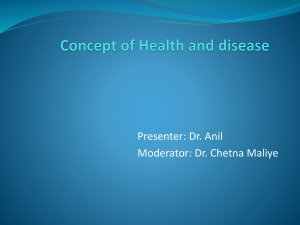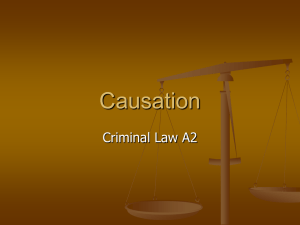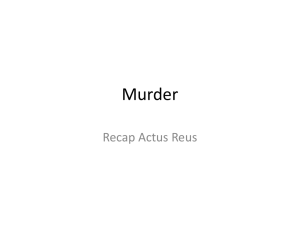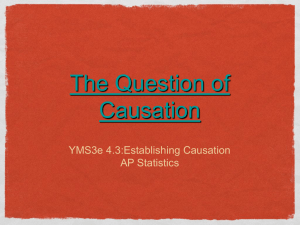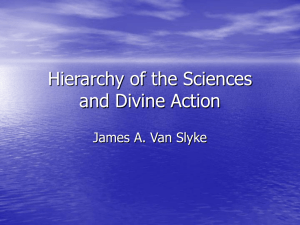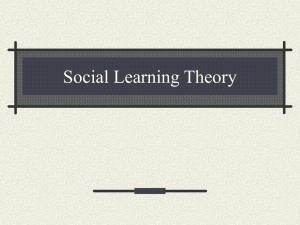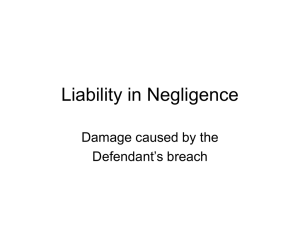Simple Causation
advertisement
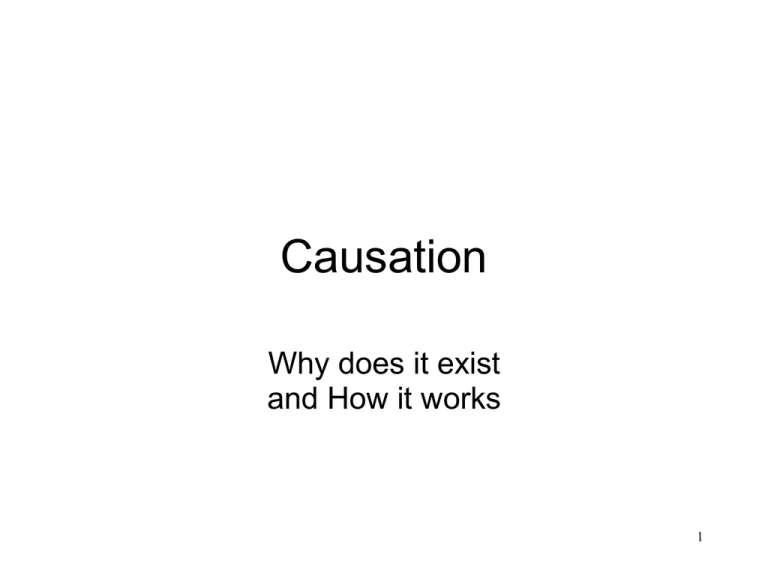
Causation Why does it exist and How it works 1 What is Causation? 1. It is only fair that a person can only be found guilty of a crime if their actions (Conduct) caused it (Consequence or result). 2. Criminal law requires the P to prove the D caused the criminal Act in most crimes before the AR can be blamed on the D. 3. This is known as proving causation. 4. ONLY crimes that require the P to prove D's conduct caused the criminal act (consequence) need the rules of causation to be proved. 5. ALL NFO's require causation to be proved. 6. So do the crimes of murder and manslaughter. Most cases are based on these crimes. 7. BUT: If the D can prove that someone or something else caused the crime there is no causation and therefore no AR. 2 Causation has 2 tests 1. Factual causation: the P to prove that the criminal act wouldnt have happened without the D's conduct. This is known as the But for test. 1. Legal Causation: The P have to prove it is fair to blame the D for the criminal act caused by his conduct. If both tests are proved by the P the D can be blamed for the AR of an offence. We say we have established "a chain of causation". 3 Why Causation exists? Example: D punches V in the eye because V told D to stop talking. V is injured with a black eye. 1. 2. 3. 4. What is the offence? What is the AR of the offence? What is evidence of the conduct of the offence? What is the evidence of the consequence of the offence what is V's injury? 5. What are the circumstances as to why V got a black eye? 6. Based on the circumstances of D's punch is it fair to blame D for the black eye? YES IT IS. As we have proved factual and legal causation we say we have a "chain of causation" which proves the AR of the crime. 4 Why Causation exists? If there are circumstances between the D's conduct and the criminal Act (consequence) that are not the D's fault then the rules of causation say the D was not legally responsible for the criminal act. Example: Marchant & Muntz: D, a farmer, was driving a tractor on a country lane with the spikes sticking down. V, a motorcyclist, was speeding at 80mph on the same lane and crashed into the tractor. V was impaled on a spike and died. D was charged with manslaughter. 1. Does D have factual and legal causation? 2. Should D be liable for the unlawful killing of V? 5 Why Causation exists? - Breaks in Causation • Where circumstances exist that are not the fault of the D then criminal law says D has no legal causation. As seen in Marchant. Example: I invite you for dinner tonight and you decide to come by bus. The bus crashes and you die. Do I satisfy the 2 tests for causation? 1. Once Factual and Legal causation are proved it is very difficult for a D to argue someone else should be at fault for a crime. 2. However, if the D can show that some circumstances between his criminal act and what happened to V was not his fault this can break the chain of causation. D is then not liable for the AR of the crime. In latin this is known as a novus actus interveniens. It would not be fair to make someone responsible for a consequence they didn’t cause 6 Breaks in the chain of causation 1. The courts have identified a number of reasons why D might break the chain of causation and not be at fault for the AR of a crime: 2. It was the V's own actions that caused the consequence 3. It was a 3rd party's unforeseeable actions that caused the consequence 4. If the D proves V's actions or an unforeseeable circumstance caused the consequence there will be a break in the chain of causation. PLEASE NOTE: Criminal law takes the view that if your conduct is even slightly of a criminal nature then you should be blamed for even the worst consequence, regardless of the circumstances. So if you push the V and they are at the top of the stairs and fall backwards. Any injury including death will be your fault. 7 Breaks in the chain of Causation 1. 2. 3. Significant and operating cause of the criminal act: The courts will not break the chain of causation for any circumstances as long as the P can prove the D's act was still a cause of the V's injuries (operating). The courts have said D's conduct must be the significant (large) cause of the V's injuries/death. Operating and substantial: The same rules as above apply except this time P must prove D's conduct was a considerable cause of V's injuries/death. D doesnt have to be the sole (only) or main cause of the V's injuries/death. As long as P can prove he is a cause. Pagett: D used his girlfriend as a human shield whilst escaping from the police. D fired a shot at the police. The police instinctively fired back, killing D's girlfriend. Did D unlawfully kill his girlfriend? 8 Causation - to sum up 1. 2. 3. 4. 5. 6. Only used where crimes need a consequence of the D's conduct to be proved - this all NFO's Has two rules that must be applied to prove casuation, factual and legal. A chain of causation is established if factual and legal causation are proved. D then has the AR of the offence. If D can prove that some circumstances other than his conduct caused the consequence he can break the chain of causation. D is not at fault and does not have the AR of the crime. Breaks in the chain can be based on the V's conduct or the unforeseeable actions of a 3rd party. Causation exists to ensure the right people are prosecuted for a crime and those situations which is truly an accident are not prosecuted. 9 In both cases outline the rules of causation for the Ds’ who are charged with murder. Airedale Trust v Bland • Tony Bland seriously injured in the Hillsborough disaster, was being kept alive only by extensive medical care (not a life-support machine). He had survived for three years in persistent vegetative state (PVS). He continued to breathe normally, but was kept alive only by being fed through tubes. He had no chance of recovery; his doctors (with the support of his family) sought a declaration from the court that it would be lawful for them to discontinue treatment so that he might die peacefully. Dr who switches life support off charged with murder. R v Malcharek • D stabbed his wife who was taken to hospital and put on a life support machine. She suffered two heart failures and after ten days had irretrievable brain damage. The doctors switched off the machine. • Malcharek charged with murder. • Dr charged who switched life support off charged with murder. 10

